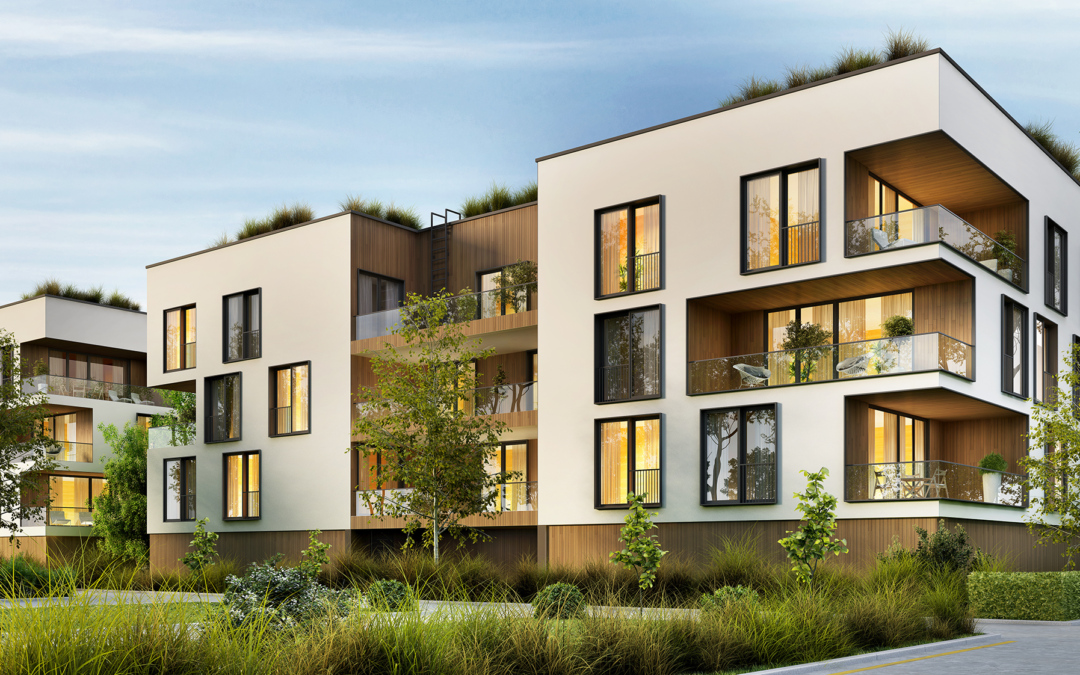When it comes to commercial properties, multifamily buildings represent a truly unique investment. On the one hand, rental units generate ongoing revenue that finance the overall operation, while the property value itself tends to (barring unforeseen circumstances or outright mismanagement) only increase over time — a sound investment indeed. On the other hand, multifamily homes are also communities of their own, where tenants raise families and build memories that can last a lifetime.
That being said, an investment is nonetheless an investment, and a truly efficient property manager must maximize the return on that investment without compromising tenant experience. Fortunately, for multifamily property managers, there are a number of strategies and best practices that can help them both reduce costs and increase the property value. And of all those, none are direct and easy to implement as energy saving measures.
Energy Efficiency Trends in Multifamily Buildings
When it comes to energy management in an MDU or other multifamily building, there’s a lot more to it than just keeping the lights on. Indeed, not only will effective energy management strategies help reduce overhead operating costs for property owners and managers, but many will also reduce costs for tenants, which in turn support tenant retention and occupancy rates.
1. Smart HVAC Energy Management
Climate control is at the heart of MDU management or any multifamily building experience. After all, the primary value-proposition of any residential offering is that it provides shelter from the elements.
Of course, there are two sides to the HVAC coin in property management. On the one hand, there are the climate control needs of common areas (e.g. lobbies, corridors, etc.). On the other hand, there are the heating and cooling costs that tenants incur within their units which, in turn, impact the value of those units.
It’s unsurprising, then, that multifamily home managers are installing smart HVAC systems to help them (and their tenants) optimize energy consumption and minimize their respective energy costs. Indeed, by installing an HVAC energy management system multifamily property managers can ensure that any given space is neither overheated or overcooled when no one is occupying it, and reduce HVAC runtime by up to 40%.
Verdant’s energy management system, Verdant Plus, for instance, offers a subscription-based service that maximizes energy savings by continuously monitoring your energy management, providing automated alerts, priority customer support, and a free onsite tech visit in the first year.
It’s worth noting, moreover, that smart HVAC systems have the lowest payback/breakeven period of any energy management system, with some commercial property managers recouping their investment in as little as 12 months. Indeed, the ROI from smart HVAC technology is so significant that it even increases property resale values.
2. Smart Thermostats
Smart climate control, of course, isn’t limited only to backend HVAC technologies. Another way that multifamily operators can improve the energy efficiency of their multifamily homes is by installing smart thermostats in both common areas and private units.
Essentially, smart thermostats allow both property managers and tenants to pre-program temperature settings around their preferences and occupancy patterns. For example, property managers themselves can program thermostats in common areas to adjust temperatures to align with high-traffic or occupancy times to ensure they are not heating or cooling vacant spaces. Similarly, tenants can program their thermostat to reduce energy consumption while they are not in the unit, allowing them to save on their own energy bills — which is a value-add that both improves tenant retention and supports occupancy goals.
Of course, MDU operators and multifamily property managers should keep in mind that not all smart thermostats are created equal. Whereas consumer-grade brands (such as Nest and Ecobee) are suitable for single family properties, larger multifamily homes with a centralized HVAC system require commercial-grade smart thermostats that are capable of managing multiple units as well as common areas.
3. Smart Lighting
Of course, part of the energy costs of ‘keeping the lights on’ is actually keeping the lights on. And in this sense, smart lighting systems can help multifamily home managers and MDU operators reduce both their own and their tenants’ energy costs.
Essentially, smart lighting employs occupancy sensors to respond to real-time occupancy patterns (similar to how smart HVAC technologies do) and time of day. It also provides tenants with a more seamless and comfortable experience as they enjoy both their units and common areas. Furthermore, it’s worth noting that many smart lighting systems can integrate with other third-party energy management systems.
4. Air Source Heat Pumps
Another HVAC hardware upgrade that multifamily property managers can invest in to reduce their energy costs is Air Source Heat Pumps (ASHPs). These reduce HVAC costs by transferring cold or warm air from outside a facility to the interior, further reducing HVAC runtimes, and ultimately reduce their energy consumption. ASHPs also offer the added advantage that they can be used as energy efficient space heaters (or coolers) to help manage energy consumption in areas of a property that are thermodynamically problematic — e.g. common areas that are either more poorly insulated or particularly high-traffic.
5. Demand Response Strategies
Onsite energy management hardware is not the only way multifamily property managers can reduce their energy costs. In fact, MDU operators turn their energy consumption into a source of revenue. Specifically, Demand Response Programs allow multifamily home operators to earn credits (or even outright cash incentives) against their energy bill whenever they choose to curb their consumption during peak demand times.
Demand Response Programs operate on an opt-in basis, and are typically offered directly through utility providers — but sometimes via independent, third-party entities. Essentially, Demand Response Programs will notify property managers prior to a forecasted peak usage event, and unless the property manager opts-out of that event, their various onsite appliances (e.g. HVAC systems, water heaters, etc.) will adjust to draw less energy from the grid. This allows MDU operators to “sell it back” to the grid, and that revenue can then be applied against their energy bills, reducing their overhead energy costs.
6. Adopting Renewable Energy
Of course, even more cost-effective than selling unused energy back to the grid is to not draw that energy from the grid in the first place. And this is precisely why some multifamily property operators are adopting more renewable and self-sufficient sources of energy.
Specifically, solar panels allow multifamily homes to reduce costs on both sides of the energy coin. On the cost side of the coin, solar panels reduce a property’s reliance on (and consumption from) mainstream power grids. On the revenue side of the coin, it allows property managers to sell back any surplus energy production to that grid.
So not only are MDU operators able to reduce the energy costs for both them and their residents, but they can also create new revenue streams or energy cost saving through Demand Response Programs that they’ve already opted into.
7. ESG Compliance
Environment Social Governance (or ESG) is one of the fastest growing trends in property management. Simply put, ESG is about adopting business practices that focus on environmental sustainability, social inclusion, and ethical governance. And in becoming ESG compliant, multifamily property managers can not only reduce energy costs, but also attract new investors, gain access to strategic financing options, and support occupancy goals.
Consequently, multifamily home managers are increasingly documenting their investment in sustainable technologies, tracking environmental data, and finding additional ways to reduce their property’s carbon footprint. Whether that means installing a smart HVAC system with smart thermostats (such as Verdant’s ZX and VX Thermostats), investing in smart lighting, adopting renewable energy sources (such as solar panels), or implementing waste management policies, achieving ESG targets don’t just reduce energy costs, but are proven to bolster MDU revenue.
8. Data-Driven Decision-Making
Energy management systems and ESG compliance are not the only way that data can be used to reduce energy costs. It can also be used to uncover otherwise hidden costs from either routine inefficiencies or catastrophic failure.
Specifically, Predictive Maintenance allows multifamily property managers to leverage sensor data from their various systems to (1) track wasteful energy consumption before those patterns become too costly, and (2) identify malfunctioning hardware and alert maintenance staff before the issue escalates to a much more problematic and costly level.
For example, as HVAC systems fluctuate through varying levels of output, their physical components undergo varying degrees of wear-and-tear. Through Predictive Maintenance, however, maintenance staff can use system performance data to (1) diagnose maintenance requirements, (2) prevent system failures and downtime, (3) reduce the costs of operating a faulty system, and (4) prevent catastrophic failures from components deteriorating beyond repair.
Energy Management and Overhead Costs
Multifamily properties rely on a range of infrastructure to operate effectively, create comfortable tenant experiences, and remain profitable. Unlike non-residential commercial properties, however, multifamily buildings and MDUs can’t compromise on many of their energy costs to improve their profitability.
Fortunately, multifamily homes have many energy management options at their disposal to reduce energy costs and even supplement their revenue streams. From smart HVAC and lighting systems to solar panels and predictive maintenance, multifamily operators are adopting smart energy technologies that reduce their operational costs, improve tenant experience, support occupancy goals, and improve their overall financial performance.



